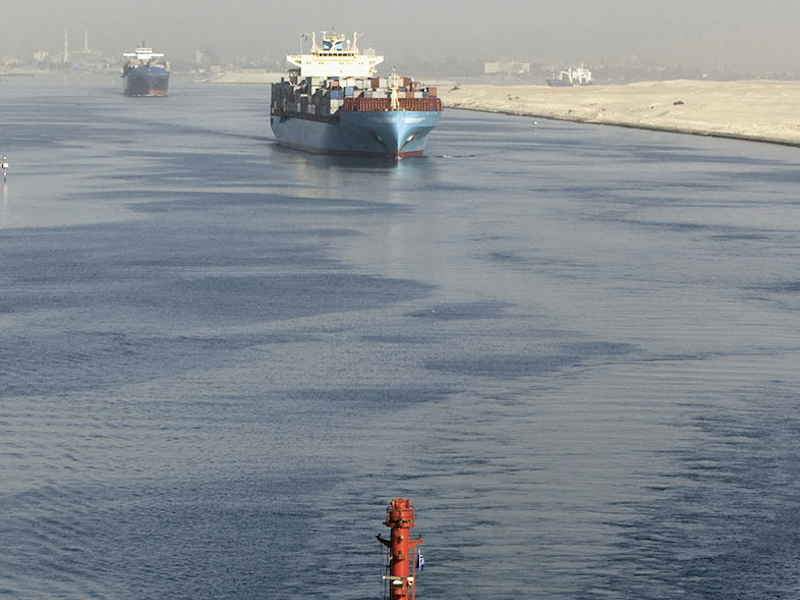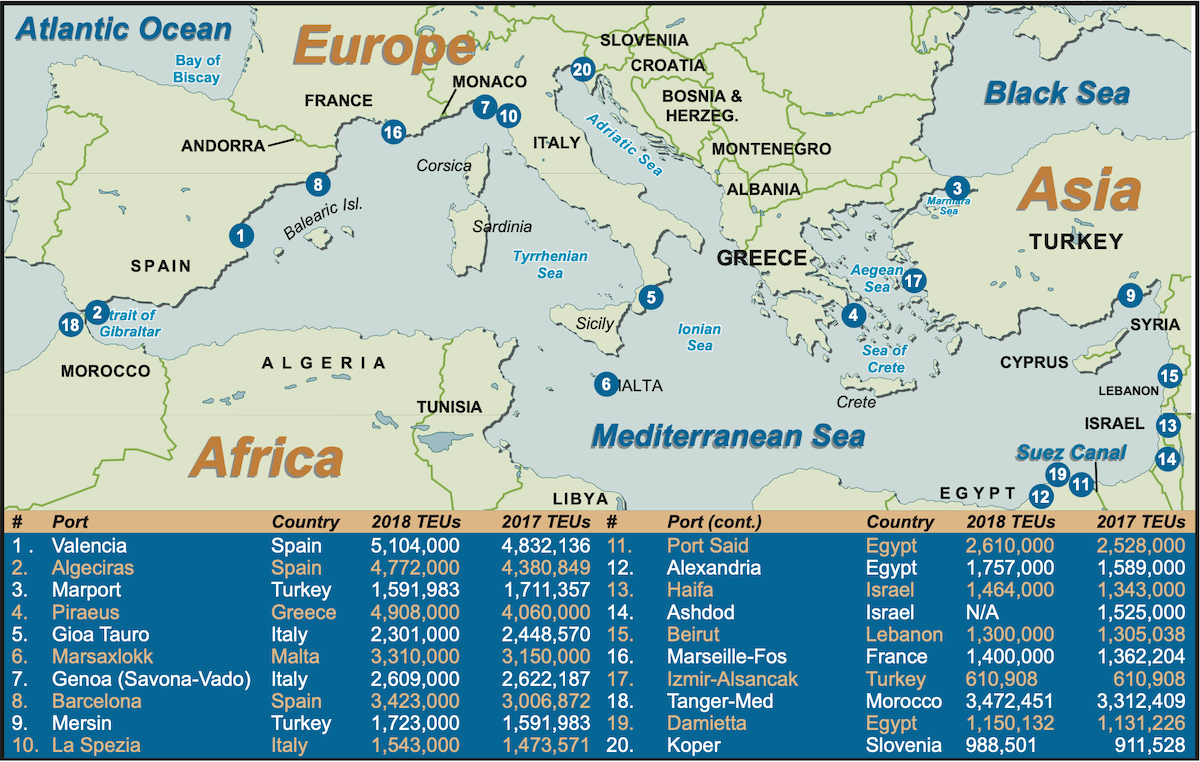The Mediterranean ports are in the middle of a vast network of trade lanes. And the competition to keep up with rising volumes and bigger ships commands more port investment.
The Mediterranean Sea is one of the most dynamic shipping regions in the world connecting the Middle East, Africa, Asia and Europe. It’s estimated that over 20% of the world’s seaborne traffic– around 120,000 ship transits – annually pass through the Straits of Gibraltar, making the narrow, nine-mile wide strait at the western end of the Mediterranean the world’s most heavily trafficked waterway. And at the southeastern end of the Mediterranean Sea lies the 120-mile long Suez Canal. In 2018, the Suez Canal, which connects the Red Sea to the Mediterranean Sea, handled over 18,500 vessels accounting for over 963 million tons. In between these iconic chokepoints lies a vast network of ports and trade routes linking more economies than any other sea region.

The ports of the Mediterranean are varied in their utilization. Ports like the Spanish ports of Valencia and Algeciras, the Tanger-Med in Morocco, Malta’s Marsaxlokk along with the Egyptian ports like Damietta, Port Said and Alexandria are transshipment hubs not only for freight moving throughout the greater Mediterranean region but act as a connector to ports as distant as the Americas or the Far East. Other ports like Genoa or Marseille serve their own industrial “catchment” regions and connect to Northern European markets.
Western Mediterranean – Competition Pushes Expansion
Located on the Moroccan side of the Straits of Gibraltar, the Port of Tangier is already the largest port in North Africa and soon may be the premier port for the entire Mediterranean Sea. With the June opening of APMT’s $800 million Tanger Med 2 Extension, the port arguably now has the largest container capacity (TEUs) in the Mediterranean and is positioning itself to become a key transshipment hub for Maersk Line and its alliance partners. The Tanger Med 2 has two new container terminals – TC3 and TC4 – with an additional 6 million TEU capacity. The TC3, which is operated by Morocco’s main port operator Marsa Maroc, has a capacity of 1 million TEUs and APM’s TC4 can handle 5 million TEUs. In 2018 the terminals accounted for 3.47 million TEUs and with the opening of Tanger Med 2, another 1 million TEUs of throughput is expected to be added by the year’s end.
It’s estimated that 90% of the volume through the port is transshipment with 20% in European trade and another 10% in the Americas. The state-of-the-art facility is taking aim at grabbing freight from the Spanish ports of Valencia and Algeciras, which handle around 10 million TEUs between them.
The overarching stratagem is to build an industrial hub served by the Tanager Med facilities. Tanger Med is located near four free trade zones including the Tanger Automotive City (TAC). TAC was opened in 2011, the Tanger Automotive City (TAC) – a free trade zone, to draw foreign automakers to invest in manufacturing and the related vehicle logistics. A main feature of TAC’s sell is the proximity to the Tanger Med facilities.

The Spanish Port of Valencia is the largest in the Mediterranean (although Piraeus is positioned to overtake them this year), tallying over 5 million TEUs in 2018. Valencia’s strategy is to be one of the ‘last’ three ports for ocean carriers to and from Europe – one of the essential transshipment hubs for transiting ocean carriers – but the port’s operating at near full capacity. So, to keep up with port competition from Tanger Med and now Piraeus, Valencia is embarking on building a fourth container terminal.
In 2018, Terminal Investment Ltd. (TIL), the terminal arm of MSC (Mediterranean Shipping Co.) proposed a $1.12 billion investment in a new facility. MSC would operate the new terminal which would be constructed in three phases. The first phase would involve building 1.1km quay and 860,000 sq./m of terminal space. This would be followed by a second phase of adding 400 m of quay and 220,000 sq./m of yard area. The third phase would add another 470 m of quay and 280,000 of terminal area. The project is scheduled to initially open in 2024. When fully completed, it is expected to add another 5 million TEUs in capacity – keeping pace with expansion in Piraeus and Tanger Med.
In 2018 the Port of Algeciras, located on the Spanish side of the Strait of Gibraltar, handled 4.77 million TEUs in 2018. The Port consists of two main facilities: the APM Terminals Algeciras and Total Terminal International Algeciras. The Algeciras can handle 18,000 TEU boxships but is looking to upgrade the port’s facility. Recently the Port Authority of Algeciras (APBA) announced it would invest 233 million euros ($259 million) over the next four years with 62 million euros ($69 million) coming in 2020. Perhaps the most important items in the plan is increasing the draft of the Juan Carlos I dock from 17 meters to 18.5 meters and the construction of new roads and esplanades to meet the demand for ro/ro traffic in the port, as well as the acquisition of a new container scanner, within the Container Security Initiative (CSI).
Northern Mediterranean Ports
The northern Mediterranean ports like Spain’s Barcelona, France’s Marseille or the Italian ports of Genoa and La Spezia are integrated into the European hinterland through rail and road networks. For the most part, container volumes have continued to rise. For example, the Spanish Port of Barcelona tallied just over 3.4 million TEUs in 2018 compared to just about 3 million in 2017. And the French Port of Marseille-FOS was over 1.4 million TEUs comparted to 1.36 million in 2017. The Italian Port of La Spezia also posted an increase, improving to 1.54 million TEUs in 2018 from 1.47 million TEUs a year earlier. The only port to post a decline was the Italian Port of Genoa (Savano-Vado) which notched 2.6 million TEUs down from 2.62 million in 2017. In the case of Genoa some of the reduced tally was the result of the August 14, 2018 collapse of the Morandi Bridge in Genoa – a main connector for the port. A replacement span is expected to open sometime in the spring of 2020.
Perhaps the biggest news in the port of Genoa is the recent merger between the Sech and the Vte, the two main container terminals. The merger of the two terminals was led by the PSA group of Singapore and by GIP, a company formed by the Infravia and Infracapital investment funds and by Giulio Schenone, the operator of Sech terminal. MSC has already voiced strong opposition to the merger and the agreement could face an anti-trust challenge.
Transshipment Hubs
The Mediterranean has nine major transshipment hubs but two stand out because of their central location, the island of Malta’s Marsaxlokk port and Gioa Tauro in Southern Italy. Both are located in the central Mediterranean – a crossroads of major trade lanes. Marsaxlokk posted 3.3 million TEUs in 2018 up over the 3.1 million a year earlier. Conversely, Gioa Tauro lost ground, tallying 2.3 million TEUs in 2018 from 2.45 million TEUs in 2017.
Despite their enviable locations, both transshipment hubs are facing challenges. Back in May, Malta Freeport announced that Maersk and MSC plan to reduce their operations at Freeport, relocating to Tanger Med and to Egypt’s Port Said. The terminal operator said the move might cut their business by up to 35%. While Maersk is expected to retain a presence and other carriers are poised to increase, the move illustrates the tenuous existence of hub ports without a major cargo catchment area attached.
In April, Gio Tauro became 100% controlled by the MSC Group as Contship Italia sold its stake to TIL – MSC’s terminal arm. MSC said it would invest 120 million euros ($133 million) for new equipment and capital works to help boost the annual throughput to 4 m TEUs within two years.
While the ports of Marsaxlokk and Gioa Tauro are fighting to retain market share, the Greek Port of Piraeus has emerged as one of the Med’s key hubs.
In 2018 Piraeus hit 4.9 million TEUs up nearly 900,000 from 2017. The key to the port’s turnaround was the investment by COSCO. In 2016 COSCO Shipping acquired a 51% stake in Piraeus Port Authority PPA. Under the COSCO aegis the port authority fortunes have flourished. Profits for the first half of 2019 were up by about 20% compared to the same period in 2018. And under the terms of the agreement should COSCO invest at least $330 million in the port by 2022, it will be eligible to up its stake by another 16%.
Recently, Greece’s Port Planning and Development Committee granted approval of an investment master plan submitted by PPA which would open the way for $670 million in infrastructure upgrades at the port. Although a proposed new 4th container terminal was not approved by the committee, the issue is not dead. The goal of the PPA is to bring the TEU capacity from the existing 7 million TEUs to 10 million TEUs – potentially making it the largest boxport in the Mediterranean.
Suez Canal Ports
Similar to other Mediterranean regions, the Eastern Mediterranean and Suez Canal ports have been the target of investment. In September Eurogate signed an MoU with the Damietta Port Authority. Eurogate plans to open a new container terminal at Damietta Port. The terminal is part of a larger plan whereby Contship Italia and Eurogate, in partnership with the Damietta Port Authority (DPA), will build the biggest logistic system in Africa and in the Middle East. Representing an investment of €750m (US$824.5m), the first phase of this project will also include a railway line, dry port and a cargo distribution area. The new terminal is scheduled to be ready for operation by the end of 2022. There was also a MOU signed in August between Hutchinson Ports and the Egyptian authorities to build a new container terminal in Abu Qir – Port of Alexandria. There is in place an Egypt Vision 2030 plan which entails a massive investment infrastructure – as part of that plan the Ismailia Tunnel which runs under the Suez Canal was built with six of the ten lanes dedicated to trucks. Back in February the Egyptian Finance Ministry announced plans for a $100 million “dry port” to be located outside Cairo. And the plan almost immediately picked up three consortia to bid on the project.






